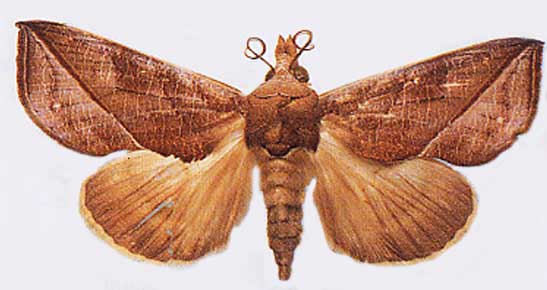
I use vampirism in moths to illustrate how to reconstruct the evolution of a behavior in a group of related species. In this case, the species are moths.
• Most moths have a delicate proboscis used to suck nectar from flowers. If most members of a group of closely related animals share some trait, then a common ancestor probably had that trait too, so we conclude that the first moths were nectar-feeders.
• Many moths supplement their diet by feeding on the sugars of damaged fruits, and by obtaining salt and other minerals from drinking mud puddles, urine, or other animal secretions. It is assumed that one of these sorts of moths was ancestral to vampire moths.
• Only a small number of moths use a stronger, raspier proboscis to scrape fruits and cause them to leak. These moths have stronger hairs at tip of their proboscis. This represents another step towards vampirism.
• In even fewer species of moths, the hairs at the tip of the proboscis are firmer, allowing the moth to use the proboscis to cut directly into thick-skinned fruits, such as oranges.
• Vampire moths (there are four species of them) must have evolved from a fruit piercing ancestor. We assume that they derive extra nutrients from blood piercing.
Back in 2013 the only photo I was able to locate, with the help of Dr. Bob Blinn
at North Carolina State University, was found on a French page at http://www.dinosoria.com/papillon/

The caption accompanying the photo was “Calyptrae ustrigata unpapillon denuit quisuce le sang desmammifères grâce trompe," which translates into English as “Calyptra eustrigata is a moth (they are called night butterflies in French) which sucks mammal's blood using its reinforced proboscis.” The adjacent text is about butterflies in general, not the vampire moth. The text right above the photo translates to “In order to fly, moths and butterflies need to increase their body temperature. To do so, moths make their wings vibrate while butterflies use solar energy. Themoroshphynx fly up to 54 kilometers an hour! Moths navigate by referring to the position of the moon or to night flowers' scent such as honey-suckle or tobacco.” That below the photo translates to “During the day, sight predominates. Moths' eyes, composed of thousands of optical units (ommatidia), perceive their environment in mosaic. The moth perceives ultra violets, but not red or infrared light. This insatiable taste for flying and odors will not last long. Numerous moth species die after a few days, right after they reproduce.”
http://www.k-state.edu/parasitology/classes/625arth42.html
Skin-piercing blood-sucking moths (Noctuidae) feed exclusively on the blood of mammals
![]()

Contact Information for the Webmaster,
Dr. Karl L. Wuensch
This page most recently revised on 22-December-2019.